A different era: the sort of Roman tunic
Kategori: Allmänt, Historic Sew Monthly 15, Stashbusting
Right. So this something I don't do everyday. On a whim I decided to try a LARP set in the late Roman period. More specifically, 364 A.D., slightly alternative-history tweaked but in a very intelligent way. The only thing the non-larper really needs to know to follow this post is that more roles were open to female players than would expect, and fashion adapted to go with it. First time in a while that I don't wear floor-lenght skirts to a LARP. Only problem: nothing Roman, not even very late-almost-dark-age/medieval-period variety. Lucky me it was a LARP and not reenactment; I could follow the guidelines/minimum requirements from the organisers and get by.
Most essential: the TUNIC, which for my role ought to be red. I got the fabric, cut into the right pieces, from a friend from my birthday. Which was a good thing! It is not madder red, since madder red wool fabric was not to be found at this time - sold out/out of stock everywhere. I only had to do minor adjustments to the pieces, and then pin together.
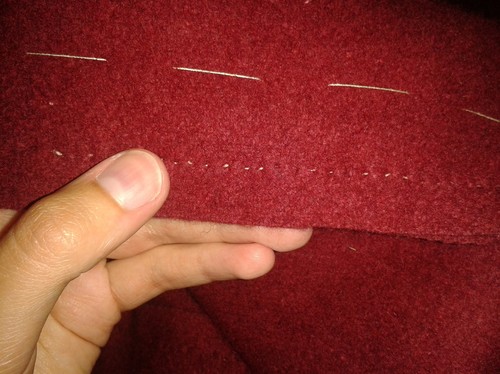
I almost never bother to do backstich anymore. I still do rather tiny stitches, though. This is what my running stitch look like in thick fabric.
For a while I tried to find out if tablet-woven edges would be period-appropriate (I am reasonably sure that tablet-weaving is), but then I decided that since this was not going to be totally HA anyway, I could just as well go ahead.
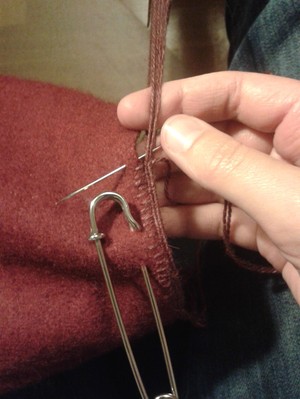
I never tried it before. It took me a while to figure out how to keep the tension of the warp, but I sort of made it in the end. The yarn is that silk/alpaca mix I've used for other projects and no, it's still not period. The colour was a decent match, though!
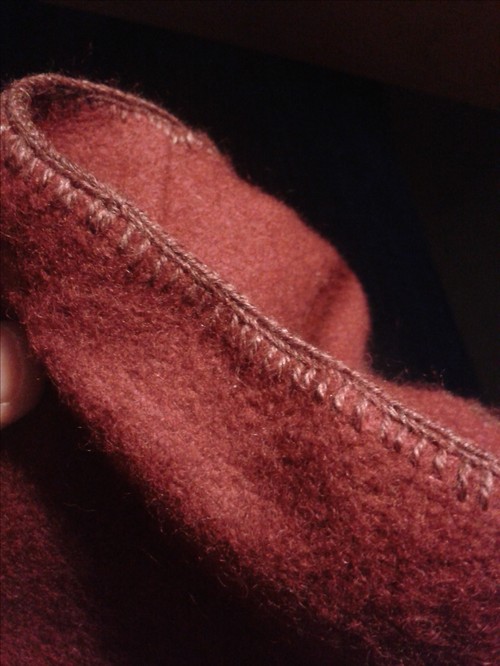
Good enough result for a first try. Eight threads/one pair of tablets. This might be the photo which is most true, colour-wise.
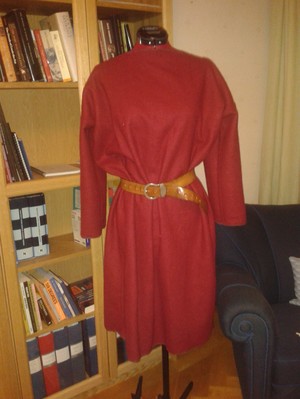
Finished tunic. Tablet-woven edges at the bottom, cuffs and cut neckline (no shoulder-seams, but sleeve seams).
I've seen nice pictures on the internet claiming that the 'coptic tunic'( which is really my reference here) is woven in one piece on a wide loom with "selvedge in cuffs and bottom" - wait, say what?! Selvedges both along the the warp and the weft? ...Well, selvedge (edges along the warp) I get, but at the same time another selvedge at ninety degrees, along the weft? No. My brain can't make that work. You have to get the fabric out of the loom in some way. Even if you do one piece of clothing at a time, there will still be warp ends that need to be cut. Can't wrap my head around how that would work, sorry. Anyone who knows, feel free to enlighten me here!
If I had woven the thing, though, I'd be able to add the clavi and roundels in the fabric. Limited to bought fabric, I had to add them later.
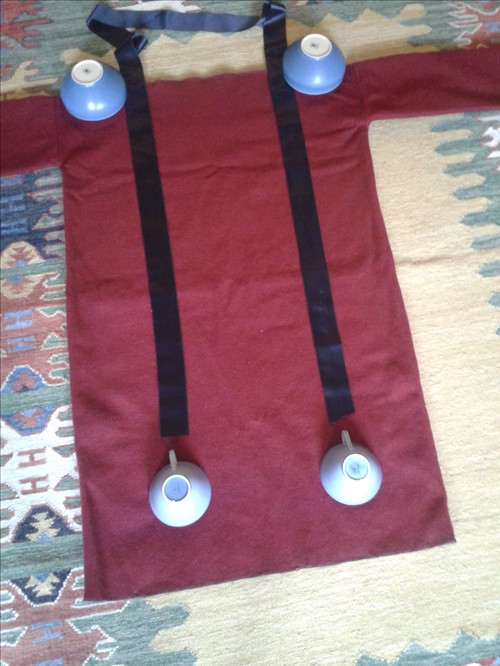
Trying out roundel size with cups and bowls. Am normal, I promise.

Cutting the narrow, straight bands for the clavi was the most frustrating part of the project. Pinning wool on wool however, is a lot easier than a lot of other types of guards I've done recently.
Since the larp was in September, rain was a possible issue. The organisers thought about that (too!) and suggested the CARACALLA/cucullus as an option, rather than a distictly 14th century liripipe hood. Said and done - I knew those corners left over from making a cloak forever a go would be good for something. A caracalla is really only a half circle of fabric, and two corners added by a seam makes a half circle.
Well. Let's just say I'm happy it didn't rain:
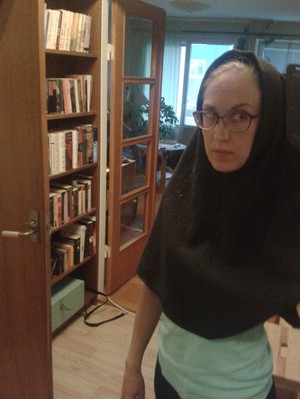
Behold my sceptic face. Behold the possibly least becoming garment ever. It's not even ugly on an advanced level, it's just ugly.
Secret weapon of the Romans: make the barbarians die from laughter. At least it worked that way in the Roman camp before larp started. I live to amuse the world around me, I really do. I did not, however, use it with the "hood" up during the LARP. For obvious reasons.

I did tablet-woven edges here as well, in black yarn. As you can see, the bias-cut edge didn't respond that well to being stretched in the process.
The scrap from the cloak fabric was also enough for a Pannonian hat, which is basically a pill-box hat. It wasn't any prettier in the 4th century, either. As the tunic hid most of them, I could use my old larp trousers and leg wraps. As for shoes, we had strict orders to make "comfy" a priority rather than "HA" and I kind of like my 3 euros-find from ten years ago.
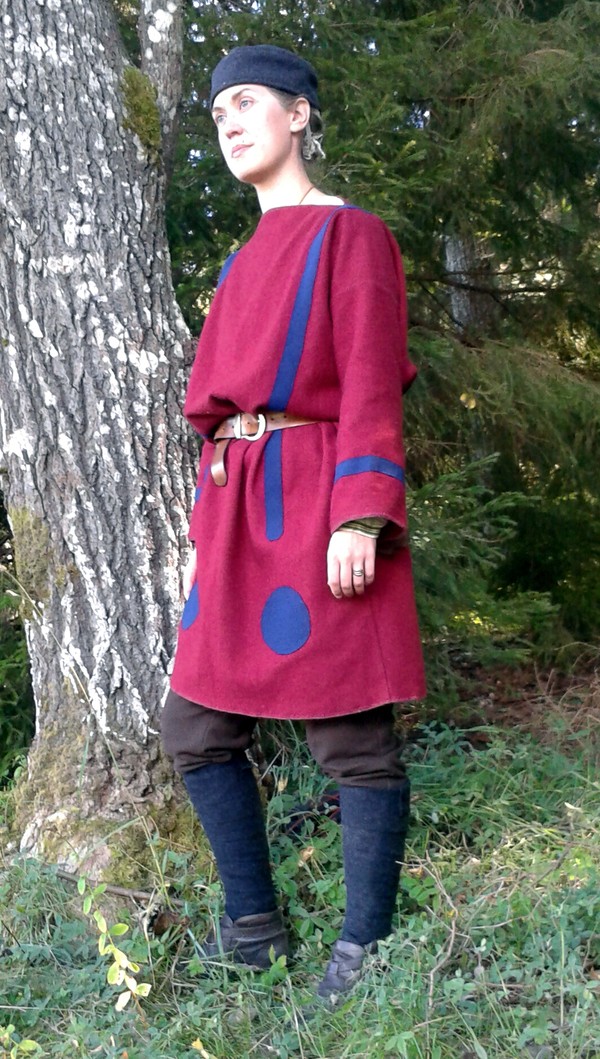
Sorry about the quality of the picture. I didn't bring a proper camera. The tunic turned out to be slightly too long, a problem easily solved by having a bit more of it above the belt. This isn't exactly a fitted garment.
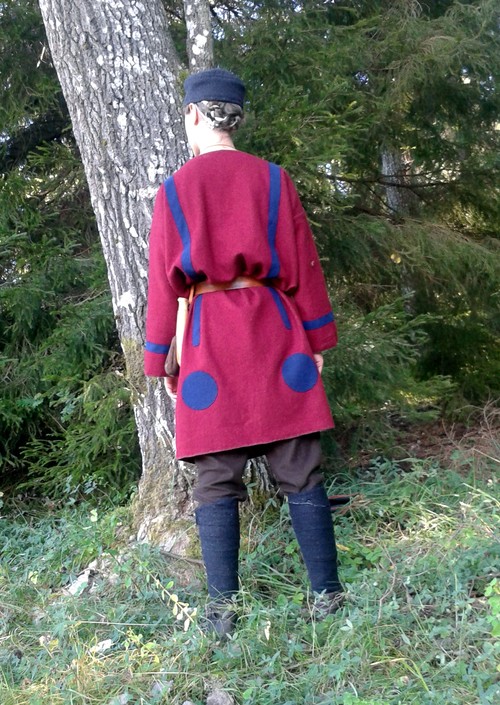
View from the back.
The hairdo is an experiment: two braids, like for Tudor styles, but my rather short braids are tied in the nape of the neck and the ribbons then secured around the head. To my immense surprise it both worked under the Pannonian hat and stayed in place all day withouth any pins or modern cheats at all. Not the fanciest hairdo, but am still pleased.
What the item is: Roman/Coptic tunic with blue clavi
The Challenge: Blue
Fabric: Red and blue wool
Pattern: None
Year: Meant to be 4th century
Notions:Silk/alpaca yarn for edges, waxed linen thread for long seams, blue embroidery threads for clavi.
How historically accurate is it? Not very. Clavi supposed to be woven into fabric, wool content for tunic not 100%, nor is the colour very madder-like. I would say 40%.
Hours to complete: Maybe 20. Attaching clavi was time-consuming.
First worn: At a larp last weekend.
Total cost: Fabric for tunic was a gift. Clavi fabric+ notions about 15 euros.
The Challenge: Blue
Fabric: Red and blue wool
Pattern: None
Year: Meant to be 4th century
Notions:Silk/alpaca yarn for edges, waxed linen thread for long seams, blue embroidery threads for clavi.
How historically accurate is it? Not very. Clavi supposed to be woven into fabric, wool content for tunic not 100%, nor is the colour very madder-like. I would say 40%.
Hours to complete: Maybe 20. Attaching clavi was time-consuming.
First worn: At a larp last weekend.
Total cost: Fabric for tunic was a gift. Clavi fabric+ notions about 15 euros.

